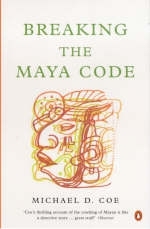
Breaking the Maya Code
Seiten
2000
|
2nd Revised edition
Penguin Books Ltd (Verlag)
978-0-14-029546-7 (ISBN)
Penguin Books Ltd (Verlag)
978-0-14-029546-7 (ISBN)
- Titel ist leider vergriffen;
keine Neuauflage - Artikel merken
An account of the decipherment of the Mayan language, which is given added impact by Coe's first-hand account of scholarly rivalries, personality clashes, and political prejudices which held back progress. The book includes illustrations of the glyphs and engravings, and two photo insets.
This is the story of how the Mayan glyphs found in the ancient ruins of Copan and other Mayan sites have been deciphered within the last 20 years. Michael Coe worked with all the leading players in this field. Although the Mayan cities were discovered a century and a half ago, the field of Mayan scholarship was dominated by scholars who had a dogmatic approach to the decipherment. Both personalities and Cold War politics slowed down the process. Then in the early 50s, a Russian scholar, Knorosov, interpreted the glyphs in a new way, comprising both phonetic and conceptual ideas. Another breakthrough, deciphering the pattern of dates in the Mayan records, followed at the end of the decade. In the 70s, studies of comparative languages furthered the decipherment, and now perhaps 85% of the glyphs can be deciphered - though many mysteries remain. This is an account of the decipherment of an ancient language, which is given added impact by Coe's first-hand account of scholarly rivalries, personality clashes, and political prejudices which held back progress for so long. The book includes many illustrations of the glyphs and engravings, and two photo insets.
This is the story of how the Mayan glyphs found in the ancient ruins of Copan and other Mayan sites have been deciphered within the last 20 years. Michael Coe worked with all the leading players in this field. Although the Mayan cities were discovered a century and a half ago, the field of Mayan scholarship was dominated by scholars who had a dogmatic approach to the decipherment. Both personalities and Cold War politics slowed down the process. Then in the early 50s, a Russian scholar, Knorosov, interpreted the glyphs in a new way, comprising both phonetic and conceptual ideas. Another breakthrough, deciphering the pattern of dates in the Mayan records, followed at the end of the decade. In the 70s, studies of comparative languages furthered the decipherment, and now perhaps 85% of the glyphs can be deciphered - though many mysteries remain. This is an account of the decipherment of an ancient language, which is given added impact by Coe's first-hand account of scholarly rivalries, personality clashes, and political prejudices which held back progress for so long. The book includes many illustrations of the glyphs and engravings, and two photo insets.
The world made visible; lords of the forest; a jungle civilisation rediscovered; forefathers - the dawn of decipherment; the age of Thompson; a new wind from the east; the age of Proskouriakoff - the Maya enter history; Pascal's people; down into Xibalba; a new dawn; a look backward, a view forward. Appendices: Proskouriakoff's "Suggested Order of Discussion"; the Maya syllabic chart.
| Erscheint lt. Verlag | 26.10.2000 |
|---|---|
| Verlagsort | London |
| Sprache | englisch |
| Maße | 128 x 198 mm |
| Gewicht | 225 g |
| Themenwelt | Geisteswissenschaften ► Archäologie |
| Geschichte ► Hilfswissenschaften ► Paläografie | |
| Geisteswissenschaften ► Sprach- / Literaturwissenschaft ► Sprachwissenschaft | |
| ISBN-10 | 0-14-029546-1 / 0140295461 |
| ISBN-13 | 978-0-14-029546-7 / 9780140295467 |
| Zustand | Neuware |
| Haben Sie eine Frage zum Produkt? |
Mehr entdecken
aus dem Bereich
aus dem Bereich
Schnelle Hilfe bei häufigen Fehlern
Buch | Softcover (2021)
UTB (Verlag)
CHF 25,20
Eine Geschichte der Welt in neun geheimnisvollen Schriften
Buch | Hardcover (2021)
C.H.Beck (Verlag)
CHF 34,95


